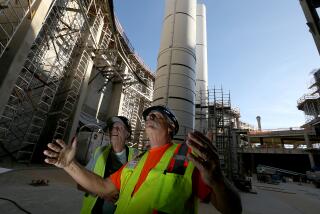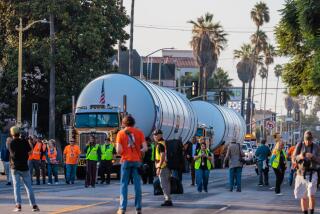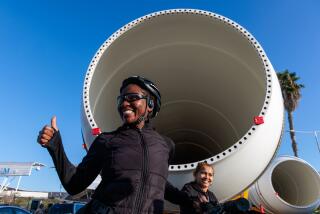Lockheed Picked to Build New Space Shuttle Rocket Boosters
HUNTSVILLE, Ala. — The federal space agency Friday awarded a contract potentially worth as much as $1.2 billion to a team led by Lockheed to build new space shuttle solid rocket boosters at a site in northeast Mississippi.
A statement released by the National Aeronautics and Space Administration’s Marshall Space Flight Center said the contract went to Lockheed Missile Systems division of Sunnyvale, Calif., for development of the rocket over a period of about seven years.
The project grew out of the Challenger space shuttle explosion Jan. 28, 1986, which killed seven astronauts.
Lockheed is teamed with Aerojet Space Booster of Sacramento as its principal subcontractor and with Rust International of Birmingham, Ala., as its facility contractor. Other members of the winning team include Babcox & Wilcox of Barberton, Ohio, Morton Thiokol of Chicago and Lockheed’s Austin division of Austin, Tex.
The Marshall center serves as manager of the space agency’s Advanced Solid Rocket Motor project.
The new rocket plant will be located near Iuka, Miss., at the site of the Tennessee Valley Authority’s abandoned, partially built Yellow Creek nuclear plant. Ownership of the property is to be transferred to NASA. The plant itself is expected to cost $200 million or more, with the design, development and testing of the rocket motor estimated at nearly $1 billion.
Mississippi’s two Republican senators, Thad Cochran and Trent Lott, issued a statement in Washington saying: “We are pleased that this important step has been taken in the process for the construction of this facility.”
The NASA statement said additional facilities will be constructed at the John C. Stennis Space Center near Bay St. Louis, Miss., for ground testing of the new motor. In addition, NASA’s existing facilities at the Michoud Assembly Facility near New Orleans will be used in the project.
Lockheed is to design, develop, test and evaluate the new shuttle rocket motor. It also will have an option to produce up to 44 motor sets.
“In addition to the design, development, test and evaluation work,” NASA said, “the primary ASRM contract will require Lockheed to produce the first 12 operational motors for use in a flight verification program consisting of six shuttle missions. The projected schedule calls for delivery of the first flight set of motors in 1994.”
Faulty O-Ring Seal Blamed
The Lockheed boosters will be phased in over the next three years, replacing the current rockets, which are built by Morton Thiokol. Space agency officials said the second-generation rocket motor will be safer and able to lift heavier payloads than the present motor.
The Challenger disaster was blamed on a faulty O-ring seal in the ship’s right-side booster. The Morton Thiokol-built boosters were redesigned in the wake of the explosion to make them less susceptible to failure. At about the same time, NASA began exploring alternate designs and the result was the ASRM program.
The new rocket motors will allow space shuttles to carry an additional 12,000 pounds of cargo into low-Earth orbit. Also, the propellant will be more powerful and the shuttle’s three liquid-fueled main engines will not have to throttle down as they do now to minimize aerodynamic stress during the first minute of flight.
The project faces funding problems and questions in Congress because of an internal NASA safety board report that challenged the need for a more powerful solid-fuel rocket to launch the space shuttle. A House subcommittee is expected to begin examining the internal assessment, written by the Aerospace Safety Advisory Panel, next week.
Firm Disappointed
Critics say that proceeding with the project implies that the current boosters, redesigned at a cost of more than $600 million, are unsafe. In addition, they say, conservative post-Challenger flight rules limit how much weight a shuttle can carry into orbit, making the excess performance of the ASRM unnecessary.
Marshall Space Flight Center officials received bids last August from the Lockheed team as well as from a team composed of Hercules Inc. of Magna, Utah, and Atlantic Research of Gainesville, Va.
“Obviously, we’re disappointed,” said Jack DeMann, a spokesman for Hercules. “We’ve put a lot of work and effort into it, but that’s NASA’s call to make and we gave it our best shot.”
He said Hercules officials plan to meet with NASA “as soon as we can for a general review and details on why they were selected and we were not.”
More to Read
Inside the business of entertainment
The Wide Shot brings you news, analysis and insights on everything from streaming wars to production — and what it all means for the future.
You may occasionally receive promotional content from the Los Angeles Times.










